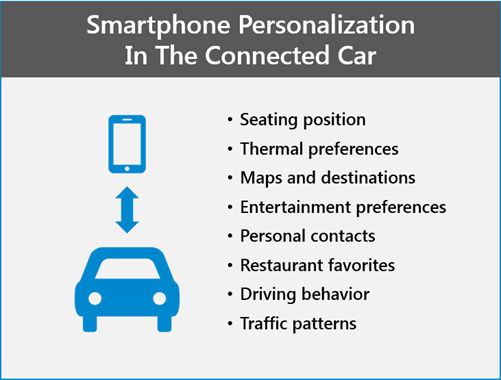Invalid input. Special characters are not supported.
For many of us, our smartphone is our lifeline, providing us with constant access to communication, entertainment, news and shopping. It is, by far, the most preferred digital device that we use every day. It is a hub that connects to everything from watches to speakers, to home security systems, and to our car. Our smartphone is also highly personalized, storing gigabytes of contacts, user preferences, and customized data that delivers a tailored user experience. It’s this combination of ubiquity and personalization that makes the smartphone so powerful.
With all of this personalization available on our smartphone, why should our experience in the car be any different? Automakers have been embracing the idea of personalization for years. Ever since BMW introduced Apple iPod connectivity in 2004, automakers have worked to integrate a personalized “smartphone experience” into the car. Fast forward to 2018, and in-car connectivity through smartphone integration is ubiquitous in new vehicles (think Ford Sync, BMW’s iDrive or Apple CarPlay and Android Auto).
Personalization: Enabling Much More than Entertainment
What the smartphone offers to the automotive technology is the opportunity to personalize and offer richer capabilities that go far beyond entertainment. Imagine getting into a rental car, and after a quick data sync with your smartphone, the car has all of your personal preferences including seat position, thermal settings, maps and addresses, phone contacts, frequent destinations, and restaurant recommendations. Instantly, this rental car has become tailored to your individual needs.
And of course, having real-time data flowing into the car also provides the potential for driver convenience, such as quickly locating parking spots. While there are already a number parking locator apps available today, now these features are more tightly integrated into the car’s navigation system, with real-time recommendations and directions to the nearest parking spots.
Personalized smartphone data can also contribute to making our roads safer. Custom-built applications take advantage of the smartphone’s sensing, computing and communications features to accurately measure the quality of human driving. These apps use accelerometers or GPS readings to provide a driving score based on factors such as braking, cornering, accelerating or compliance to speed limits. The potential for assigning a “driver score” could not only inspire better driving behavior, but is being used by insurance companies to enable more customized insurance and offer rewards for good driving.

Equipping the car—and the mobile device—with better memory technology
While many of these capabilities are here, others are on the horizon. True connected car personalization requires a tighter collaboration between the car’s internal platform and smartphone applications. Additionally, the industry will need a standardized way to interpret data so that the user experience is the same regardless of the vehicle.
Manufacturers understand that memory is one of the most critical components for delivering this advanced integration and functionality.
Memory provides the underlying code, data, and parameters for most of the car’s electronic systems, including advanced driving assistance (ADAS), heads-up display (HUD), dashboard instrumentation, navigation, infotainment and powertrain.
The smartphone’s memory subsystem must evolve as well. As software developers up the ante on richer personalized experiences, the mobile device must be equipped to handle the barrage of data that richer applications will create. While the car accesses the smartphone’s various applications and personalized datasets, the mobile device is constantly “file caching” and reading/writing into memory. This scenario requires both increased memory size and improved storage performance.
Micron is in a unique position to provide both the solutions and the expertise for optimizing car and smartphone technology. We deliver a diverse portfolio of high-performance DRAM and non-volatile Flash memory that meet the unique requirements of quality, reliability, and temperature. But more importantly, we offer hands-on support through dedicated architecture teams to solve some of the most difficult challenges.
Moving forward, new opportunities are on the horizon for personalization in the connected car. The upcoming 5G cellular network, with throughput up to 20 times faster than existing 4G LTE networks, offers a lot of promise for both mobile devices and the automotive space. These blazing fast speeds will move more data between the smartphone and car, driving the need for even faster memory and higher capacity storage. Micron is well positioned to solve these future challenges with advanced memory technologies, including LPDDR4x, UFS 3.0, GDDR6 and QLC NAND Flash.
It’s clear that innovation in both automotive and smartphone technologies isn’t standing still. It is certain that fully autonomous driving will become a reality, smartphone camera resolutions will get higher, multimedia will become richer, and the amount of car sensors and accelerometers will increase. For these reasons, it’s critical that the vehicles continually employ a better, faster, and more sophisticated memory and storage subsystem to enable the future driver experience.